![]()
![]()
![]()
Use LEFT and RIGHT arrow keys to navigate between flashcards;
Use UP and DOWN arrow keys to flip the card;
H to show hint;
A reads text to speech;
102 Cards in this Set
- Front
- Back
- 3rd side (hint)
|
Magnets always have
|
at least two poles (north and south)
|
|
|
|
A magnetic force field is
|
a region around a magnet where a magnetic object feels a push or pull
|
|
|
|
A magnet will attract
|
a steel paperclip
|
|
|
|
The purpose of sprinkling iron filings around a bar magnet is to
|
visualize the lines of magnetic force
The iron filings show the lines of magnetic force. The force is strongest where the iron filings collect most densely |
|
|
|
What is a magnet
|
an object that produces a magnetic field outside itself
|
|
|
|
How are magnets magnetized (given a magnetic field)
|
by heating them up and exposing them to a magnetic field
|
|
|
|
Do magnets always have an even or odd number of poles
|
even, you can't have a north or south pole in isolation
|
|
|
|
like poles repel each other while _______ attract
|
opposites
|
|
|
|
Where is the magnetic field the strongest
|
at the pole of a magnet - the lines of force collect there
|
|
|
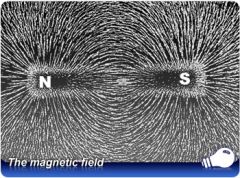
status quo
|
状
|
The turtle and Chihuahua wished to marry however their family’s refused and argued to maintain the status quo.
|
|
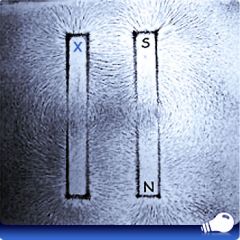
The end of the bar marked X is
|
a north pole
|
|
|
|
The needle of a compass points to
|
north
|
|
|
|
Geographic north is determined by:
|
Earth’s spin axis
|
|
|
|
A compass helps find geographic north because:
|
Magnetic north is close to geographic north
|
|
|
|
The purpose of the cork floating on water in a homemade compass is:
|
to ensure that the needle moves freely
The needle of a compass must always be able to pivot or move freely so that it can align itself with Earth’s magnetic field |
|
|
|
what's the difference between true north (geographic north) and magnetic north
|
Earth’s spin axis defines the North and South Poles, so true north always stays in the same location. But Earth’s magnetic poles shift around.
|
|
|
|
What's the angle between geographic north and magnetic north
|
About 11 degrees
|
|
|
|
How do you build a simple compass
|
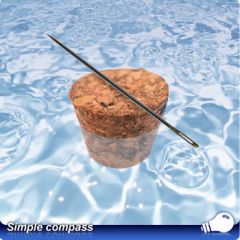
lay a magnetized sewing needle on a thin slice of cork and let the cork float in a glass of water. The needle will slowly turn and orient itself to point north.
To magnetize a needle, stroke it along a magnet about 50 times in the same direction — from the center of the magnet to the tip. (Don’t run it back and forth over the magnet!) The needle is magnetized when it picks up iron filings. |
|
|
|
How can you tell which end of your needle points north
|
It depends on if you are in the northern or southern hemisphere.
If you live in the northern hemisphere, take the compass outside around noon. The Sun is to the south. The end of the needle that is pointing away from the Sun is the north-pointing end. If you live in the southern hemisphere, take the compass outside around noon. The Sun is to the north. The part of the needle that points toward the Sun is the north-pointing end |
|
|
|
A compass may be useless if:
|
Nearby magnetized rocks can throw off the accuracy of a compass
|
|
|
|
Two balloons are rubbed against cloth. They will then:
|
repel each other and attract small pieces of paper
The balloons will repel each other because they are similarly charged, but they will both attract small pieces of paper. |
|
|
|
When atoms or molecules in an object orient themselves so that there is a positive charge at one end and a negative charge at the other, the object is said to be
|
polarized
|
|
|
|
A balloon that has been rubbed against cloth is said to be charged by
|
friction
|
|
|
|
A glass rod becomes positively charged after being rubbed with a cotton cloth
|
negative charge moved from the glass rod to the cotton
Electrons, which carry negative charge, are relatively free to be transferred between objects by friction. If the glass rod became positively charged, it must be because it gave up electrons to the cotton cloth. No charges were created or destroyed by friction. The electrons simply moved from the glass rod to the cotton. |
|
|
|
the science of electric charge at rest is
|
electrostatics
|
|
|

Two balloons on strings are rubbed against a volunteer’s hair. What is the balloons net charge, what is the hairs net charge
|
The friction of the rubbing draws electrons from the hair onto the surfaces of the balloons, because the material the balloon is made of has a greater affinity for electrons than the hair does.
The balloons, which previously were neutral, each acquire a net negative charge from the negatively charged electrons. (The hair has a net positive charge, so the sum of the hair and balloon charges is zero.) |
|
|
|
Eventually, if a balloon and piece of paper stick together, the paper falls off. Why?
|
Water vapor and other electrically polarized molecules in the surrounding air can remove excess charge.
|
|
|
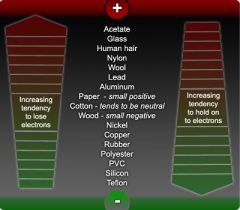
Materials higher up in the list have a tendency to give up electrons and be positive, while materials lower down acquire electrons and become negative. A cloth made of natural fiber like cotton tends to quickly lose any charge it gains because it can draw a neutralizing charge from the ground through the body.
Explain this |
Charging by friction works best with two materials that have a different affinity for electrons
|
|
|
|
How does charging by conduction work
|
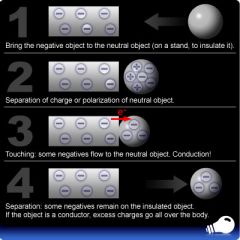
A neutral object may be charged by touching it with a charged object. the initially neutral object must be insulated from ground
|
|
|
|
How does charging by induction work
|
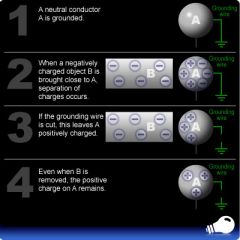
Charging by induction is like charging by conduction, except that the two objects never actually touch. The inductively charged object gets its charges through a grounding wire
|
|
|
|
The spark of static electricity is caused by
|
A sudden electrostatic discharge.
Our feet tend to draw electrons out of a carpet as we shuffle across it. Then, when we touch a metal object (such as a doorknob), the excess electrons flow between finger and doorknob. The brief current through a very small area of the body (the fingertip) is felt as a tingling sensation. |
|
|
|
Compare electrostatics and magnetism
|
Only a few elements can be magnetized: mainly, iron, cobalt, and nickel. However, almost any substance can be electrified or acquire a charge.
A magnet always has at least two opposite poles, north and south, and its magnetic field is concentrated at these poles. However, an object may have just one electric charge, positive or negative. |
|
|
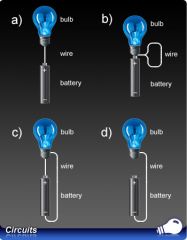
Which of the following circuits will light the bulb?
|
example c
|
|
|
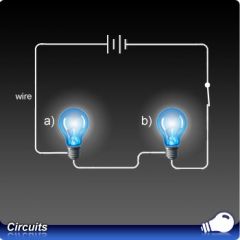
If light bulb B burns out, what happens?
|
Bulb A does not light
The circuit is broken so A does not light |
|
|
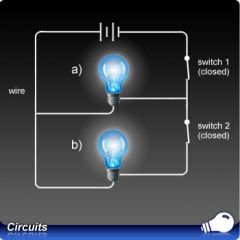
If switch 2 is opened, what happens?
|
Bulb b goes dark
B goes dark as the current stops flowing through it, but current continues to flow through A |
|
|
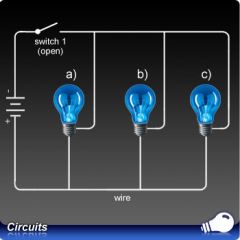
When the switch is closed, how do the bulbs light up?
|
A, B, and C light up at the same time
When the switch is closed, current starts flowing everywhere in the circuit at the same time. There is no delay in the lighting up of the bulbs. They all light at once. |
|
|
|
A ______is a complete path through which an electrical current (or stream of electrons) can flow
|
circuit
|
|
|
|
A simple series circuit consists of 5 components including:
|
wires through which electrical charge flows
a battery or power supply to provide the voltage to push charge around the circuit (that is, to drive the current) a switch to interrupt the current a resistor (which dissipates energy) a light bulb or other component, which works when current flows through it |
|
|

There are several incorrect ways to build a circuit. Explain the correct way (c)
|
The correct way is to connect one terminal of the battery to the light, then connect the light to the other terminal of the battery, as shown in (c).
|
|
|
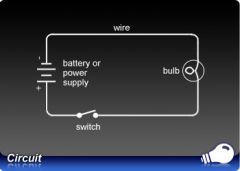
In this circuit, current flows from a battery through a switch (when it is closed), then through a bulb, and back to the battery. The current flows simultaneously through all parts of the circuit. The current is present everywhere in the wires and components. When the switch is closed, electrical charges start moving from everywhere at once.
What are the four steps to build this circuit |
Attach one end of the wire to one terminal of a battery or to the terminal labeled “1.5 Volt” of a DC power supply. (The clips on the end of the wire are called alligator clips.)
Attach the other end of the wire to one end of the switch (the switch should be open when you set up the circuit). Using another wire, connect the other end of the switch to one of the screws at the base of the light bulb component. (In some setups, you must twist the wire around the screw to make electrical contact.) Then run a wire from the second light bulb screw to the terminal labeled “common” on the power supply. |
|
|
|
How does a resistor function in a simple series circuit
|
A resistor functions like a flow restrictor on a showerhead, “resisting” the current and limiting the flow of electrons. In each collision, an electron that is helping to carry the current in the circuit loses a little bit of energy.
|
|
|
|
In a ______ circuit, the electrical current flows in two or more closed paths simultaneously.
|
parallel
|
|
|

How does a parallel series circuit work
|
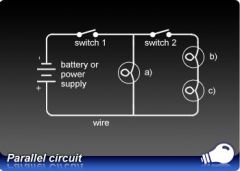
In this circuit, one path includes a battery, switch 1, and light bulb a. The other path includes the same battery, switch 1, switch 2, and two light bulbs b and c.
When switches 1 and 2 are both closed, current flows though bulbs a, b, and c simultaneously. If light bulb a is unscrewed, bulbs b and c stay on. If switch 1 is closed and bulb a is screwed in, and switch 2 is opened, current continues to flow through a. The two branches of the circuit are independent |
|
|
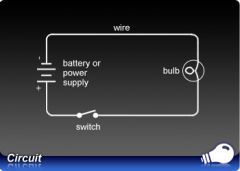
A light bulb must be added in parallel to this circuit. Where should the two connections be made?
|
Connecting the bulb at B and C will add it in parallel.
|
|
|
|
A battery converts _________ into electrical energy
|
chemical energy
A battery relies on chemical reactions |
|
|
|
A load in an electrical circuit is:
|
A load is something that dissipates energy, such as a light bulb or an appliance
|
|
|
|
Voltage is provided by
|
A battery or cell
|
|
|
|
In an analogy between an electric circuit and a water park with slides, the battery is analogous to:
|
a pump to raise the level of the water
Water flows due to a difference in pressure, or a difference in level above ground. A pump raises the water to the top of a slide so that it will flow down. Similarly, a battery raises the voltage that “pushes” the electrons through a circuit |
|
|
|
water in a water park is like
|
electric current in a circuit
|
|
|
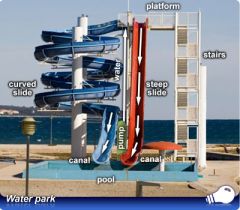
How is this analogous to an electrical circuit
|

The water is analogous to electric current. The current flows through the entire circuit at once, rather than starting at one terminal at one time and passing through various circuit elements at later times.
The canal is analogous to conducting wire that carries the electricity through the circuit. The valve is analogous to a switch that turns the electricity on and off. The slides are like light bulbs or other loads in an electric circuit, where energy is dissipated |
|
|
|
What is a voltage difference and name an analogy
|
The difference in water level is like the voltage difference between two points in a circuit. Water will not flow unless there is a difference in pressure (caused by a difference in level above ground, or a pump to raise its level)
Electrons will not flow through a circuit unless there is a voltage difference between two points in the circuit and a voltage source to sustain that potential difference. |
|
|
|
Name some sources of current and power in electrical circuits
|
batteries, electric generators, fuel cells, and solar cells
|
|
|
|
In a light bulb, energy from electricity is converted to
|
heat and light
|
|
|
|
An ampere measures
|
the amount of charge flowing per unit time
An ampere is the flow of `6.25 x 10^18` electrons per second, or charge per unit time. |
|
|
|
Voltmeters are connected in ________ and ammeters in _________
|
Voltmeters are connected in parallel and ammeters in series
|
|
|
|
Electrical potential difference is measured with
|
a voltmeter
|
|
|
|
What is current
|
the flow of electrical charge
|
|
|
|
What are the units of current
|
The units of current are amperes or amps (symbol A). One amp is a flow of `6.25 x 10^18` electrons per second. If the charge is carried by ions instead of electrons, as may be the case in semiconductors, an amp is an equivalent flow of charge per second.
|
|
|

Knowing how to connect an ammeter to a circuit is important. An ammeter is connected in series. What does that mean
|
the ammeter is inserted into the circuit at the point where one wants to measure the current.
|
|
|
|
_______ is analogous to a difference in pressure or in water level at a water park
|
voltage difference
Water naturally flows from high pressure to low, or from an elevated place to a lower one. Similarly, a potential difference across a segment of a circuit drives the current through the circuit. |
|
|
|
How is voltage difference measured
|
in volts (symbol V)
|
|
|
|
What do we mean when we say that the voltage at point A in a circuit is 5 V.
|
we mean 5 V is the difference between A and ground.
Ground can be a connection to the earth, or it can be a connection with something that, like Earth, provides constant potential or voltage level. |
|
|
|
how is resistence measured
|
Resistance is measured in ohms (symbol `Omega`).
Resistors are marked with three color-coded bands to indicate resistance |
|
|
|
You are using an ohmmeter to measure resistance in a circuit, and get a result of extremely high resistance. This could mean:
|
An open circuit, in which there is a break in the electrical path, will give an “infinite” resistance
|
|
|
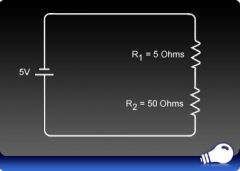
The total current is:
|

`I = V/R = (5V)/(55 Omega) = 0.09 = 0.1 A`
|
|
|
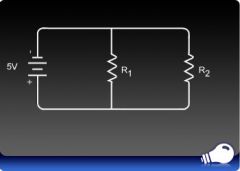
R_1` is 10 `Omega`. The total effective resistance in the circuit is:
|

less than 10 `Omega
When resistors are connected in parallel, the total effective resistance is less than the value of any one resistor |
|
|
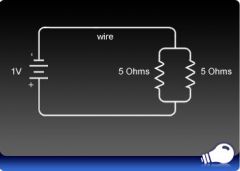
The total current is:
|

R_T = (5 x 5)/(5+5) = 2.5 Omega` Therefore `I = V/R = (1 V)/(2.5 Omega) = 0.4 A`
|
|
|
|
The current I2 is
|
I_2 = (V_2)/(R_2) = (5V)/(500 Omega) = 0.01 A
|
|
|
|
R_T is the symbol for
|
total resistence
|
|
|
|
If two or more resistors are linked in a closed loop, the total resistance is just the
|
sum of the individual resistences
|
|
|
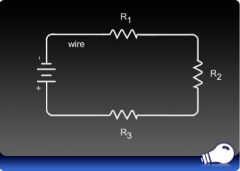
calculate the total resistence (T_R) if If `R_1 = 100 Omega, R_2 = 5000 Omega`, and `R_3 = 1 Omega`
|
the total resistance `R_T = R_1 + R_2 + R_3`
the total resistance is `100 + 5000 + 1 or 5101 Omega |
|
|
|
Resistors in parallel circuits form an
|
equivalent resistance
|
|
|
|
Req and R_T are used interchangebly to stand for
|
total equilvalent resistence
|
|
|
|
If the circuit just has two resistors in parallel the general formula is
|
`Req = (R_1 x R_2)/(R1 + R_2)`
|
|
|
|
If the circuit has three resistors in parallel, the general formula is
|
`Req = (R_1 x R_2 x R_3)/(R_1 + R_2 + R_3)`
|
|
|
|
Say `R_1 = 5 Omega, R_2 = 10 Omega` in the illustration at right.
Then the equivalent or total resistance is |
`R_T = ((5 Omega) (10 Omega))/(5 Omega + 10 Omega) or (50 Omega)/(15 Omega) = 3.3 Omega`
|
|
|
|
I = V/R stands for
|
the total current
|
|
|
|
Say `V = 9 V`, `R_1 = 5 Omega` as above, `R_2 = 10 Omega` as above.
What is the total current |
Then the total current `I = V/R = (9 V)/(3.3 Omega) = 2.7 A.
|
|
|
|
Notice that the total or effective resistance in the circuit with parallel resistors is _____ than the value of any individual resistor.
|
less
In this example,the total resistance is 3.3 `Omega`, which is less than either the 5 `Omega` or the 10 `Omega` resistor. |
|
|
|
adding resistors in parallel _________ the total resistance
|
DECREASES
|
|
|
|
adding resistors in series _________ the total resistance,
|
INCREASES
|
|
|
|
resistors "resist" the
|
flow of current
|
|
|
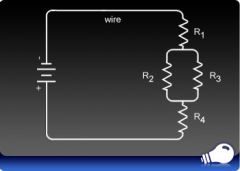
`R_1 = 1 Omega`,
`R_2 = 5 Omega`, ` R_3 = 8 Omega`, `R_4 = 11 Omega` How do we find the total resistance? |
1. Find the equivalent resistence of the two resistors in parallel, R_3 and R_3
`R_23 = (R_2 R_3)/(R_2 + R_3)` R_23 = (5 x 8)/(5 + 8) = 3 A` Now that segment adds in series with the other two resistors `R_1` and `R_4`: `R_T = R_1 + R_23 + R_4` R_T = 1 + 3 + 11 = 15 A |
|
|
|
The current put out by a voltage source is neither created nor destroyed, so
|
the sum of the current in each loop of a multi-loop circuit must add up to the total
|
|
|

As a check on our calculation of the total current of 2.7 A, we can figure out the currents in each parallel path. The currents in the two paths must add up to the total current. Calculate the current.
|
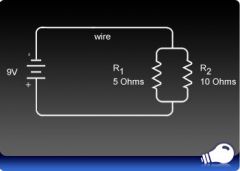
In the path with `R_1`, we have `I_1 = V/R = (9 V)/(5 Omega) = 1.8 A`.
In the path with `R_2`, we have `I_2 = V/R = (9 V)/(10 Omega) = 0.9 A`. Total current `I_1 + I_2 = 1.8 + 0.9 = 2.7 A`. |
|
|
|
The sum of the voltage differences around a circuit must add up to ____
|
zero
Remember the water-park analogy: the drop in water level from the top of the slide to the bottom must equal the rise in water level given by the pump |
|
|
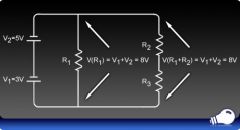
How do you calculate voltage drops
|

The applied potential or emf in this circuit is `V_1 + V_2` — that’s the total rise in potential.
The potential drop across `R_1` must be `(V_1+ V_2)`; the drop cancels the rise. The potential drop across `R_2` and R3 together must also be `(V_1+ V_2)`. If `V_1 = 3 V` and `V_2 = 5 V`, then the potential drop across `R_1` is 8 V and the potential drop across the `R_2-R_3` leg of the circuit is also 8 V. |
|
|
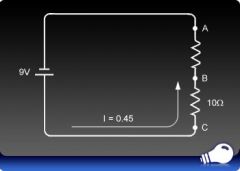
The current at C is measured to be 0.45 A. What is the potential drop between A and B?
|

The potential drop across B-C is given by V = I R, where I = 0.45 A and R is 10 `Omega`. Thus the potential drop across B-C is 4.5 V. Now the total drop across both resistors must add up to the source voltage, 9 V. Therefore the voltage drop across the remaining part of the circuit, A-B, must also be 4.5 V.
|
|
|
|
What is Ohm's law
|
Using I for current in amps, V for potential difference in volts, and R for resistance in ohms, Ohm’s law is
I = V/R It makes sense that the higher the voltage, the more current is pushed through a circuit, and the higher the resistance, the less current flows. |
|
|
|
A magnet that uses electric current to create the magnetic field is called
|
An electromagnet uses a coiled current-carrying wire to create a magnetic field
|
|
|
|
The main advantage of an electromagnet over a permanent magnet is
|
Electromagnets can easily be turned on or off with a switch, and the field can be reversed by reversing the current direction in the wires
|
|
|
|
When more turns of wire are added to an electromagnet, in the same direction as the original windings
|
The magnetic field strength increases.
|
|
|
|
The purpose of an electrical transformer is
|
to change the voltage between two circuits
A transformer may increase or decrease the voltage as the current passes from one circuit to another. |
|
|
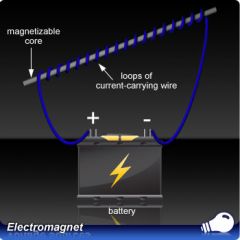
When the current is flowing
|
it generates a magnetic field that magnetizes the core
|
|
|
|
A current flowing in a long straight wire automatically generates a circular magnetic field around the wire. How do we find the direction of the field created by the straight wire
|
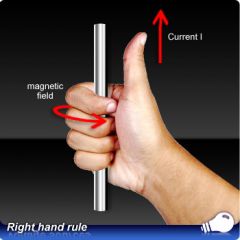
The right hand rule. the thumb points in the direction of the current, and the fingers curl in the direction of the magnetic field. The magnetic field arrow indicates north for that particular point on the circle. There is no single “north” or “south” point. At any given point in the circle of magnetic field lines, the way the fingers point is north
|
|
|
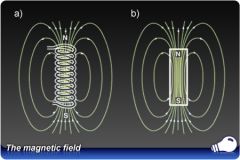
Winding the wire in loops changes the overall form of the magnetic field
|

Figure a shows the magnetic field generated by a current-carrying wire that has been wound into loops (an electromagnet). Figure b shows the magnetic field of a bar magnet. Notice the similarity of the two magnetic fields.
|
|
|
|
What is an application of an electromagnet
|
An application of an electromagnet is to pick things up — such as wrecked cars in a junkyard — move them, and then release them at another location by turning off the current and field.
|
|
|
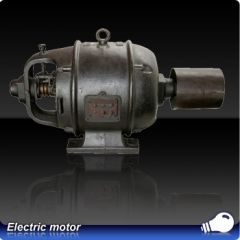
An electric motor converts electrical energy to mechanical energy (the turning of the rotor). The rotor can in turn move a shaft, or otherwise do mechanical work.
Inside the motor is a magnetic field created by an electromagnet. Explain this process |
A current-carrying wire inside the motor, in the space permeated by the magnetic field, turns as a result of the interaction of the current in the wire and the magnetic field from the electromagnet
|
|
|
|
An electric generator is a motor in reverse
|
it converts mechanical energy to electrical energy
|
|
|
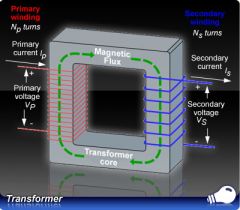
An electrical transformer changes the voltage between two circuits. what does the transformer consist of
|

The transformer consists of an iron core, usually in the shape of a “square donut,” with wire windings on either side. The relative number of windings on each side is used to determine the voltage step.
|
|
|
|
The transformer has voltage `V_1` and number of turns of wire `N_1` on the input side, and voltage `V_2` and number of turns of wire `N_2` on the output side.
The transformer equation is |
V_2/V_1 = N_2/N_1
That is, if `N_2` is greater than `N_1`, then the output voltage is a step up from the input voltage and the transformer is a step-up transformer. |
|
|
|
An electric generator converts
|
A generator is like a motor in reverse. It converts mechanical to electrical energy
|
|

